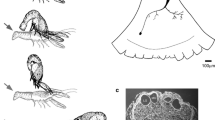Summary
-
1.
A direct comparison of the relative sensitivity of the lateral-line system in swimming and in stationary fish was made by recording the total response of the anterior lateral-line nerve in decerebrate dogfish while the infraorbital lateral-line canals were stimulated.
-
2.
During vigorous body movements, of the type made in “escape reactions”, the early components of the lateral-line response were attenuated by as much as 30 dB and the later components were completely abolished (Fig. 2).
-
3.
This strong attenuation depended on two interacting factors: (i) the violent body movements created water currents which interacted destructively with the lateral-line stimulus; (ii) there was, in addition, an active reduction in sense-organ sensitivity which was attributed to the inhibitory action of the efferent lateral-line system.
Similar content being viewed by others
References
Bone, Q.: On the scabbard fishAphanopus carbo. J. marine biol. Ass.51, 219–226 (1971)
Borg, E.: Acoustic middle ear reflexes: A sensory-control system. Acta oto-laryng. (Stockh.) (Suppl.)304, 1–34 (1972)
Breder, C. M.: Vortices and fish schools. Zoologica50, 97–114 (1965)
Flock, Å.: The lateral line organ mechanoreceptors. In: Fish physiology (W. S. Hoar and D. J. Randall, eds.), vol. V, p. 241–263. New York: Academic Press 1971
Flock, Å., Russell, I. J.: Efferent nerve fibres: postsynaptic action on hair cells. Nature (Lond.) New Biol.243, 89–91 (1973)
Gertychowa, R.: Studies on the ethology and space orientation of the blind cave fishAnoptichthyg jordani. Folia biol. (Kraków)18, 9–69 (1970)
Lissmann, H. W.: Zoology, locomotory adaptations and the problem of electric fish. In: The cell and the organism (J. A. Ramsay and V. B. Wigglesworth, eds.), p. 301–317. Cambridge: University Press 1961
Norris, H. W., Hughes, S. P.: The cranial, occipital and anterior spinal nerves of the dogfish,Squalus acanthias. J. comp. Neurol.31, 293–404 (1920)
Pumphrey, R. J.: Hearing. Symp. Soc. exp. Biol.4, 3–18 (1950)
Roberts, B. L.: Activity of lateral-line sense organs in swimming dogfish. J. exp. Biol.56, 105–118 (1972)
Roberts, B. L., Russell, I. J.: The activity of lateral line efferent neurons in stationary and swimming dogfish. J. exp. Biol.57, 435–448 (1972)
Russell, I. J.: The influence of efferent fibres on lateral line organs. Ph. D. Thesis. Cambridge (1969)
Russell, I. J.: The role of efferent fibres in the lateral line system ofXenopus laevis. J. exp. Biol.54, 621–641 (1971a)
Russell, I. J., Roberts, B. L.: Inhibition of spontaneous lateral-line activity by efferent nerve stimulation. J. exp. Biol.57, 77–82 (1972)
Schwartz, E.: Analysis of surface wave perception in some teleosts. In: Lateral line detection (P. Cohn, ed.), p. 123–144. Bloomington: Indiana University Press 1967
Shelton, P.: The structure and function of the lateral line system in larvalXenopus laevis. J. exp. Zool.178, 211–231 (1971)
Author information
Authors and Affiliations
Additional information
I. J. R. was supported by a grant from the Science Research Council.
Rights and permissions
About this article
Cite this article
Russell, I.J., Roberts, B.L. Active reduction of lateral-line sensitivity in swimming dogfish. J. Comp. Physiol. 94, 7–15 (1974). https://doi.org/10.1007/BF00610153
Received:
Issue Date:
DOI: https://doi.org/10.1007/BF00610153




